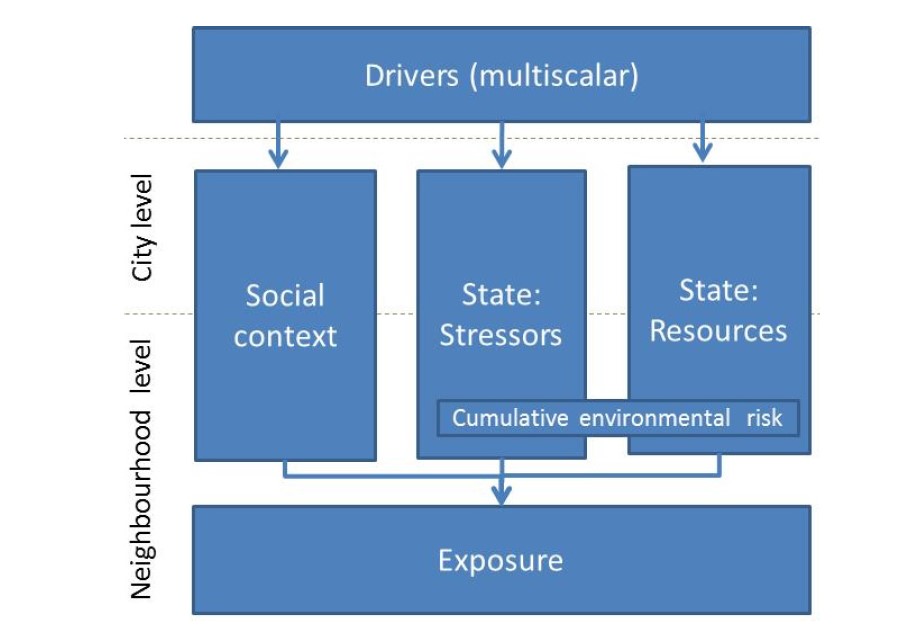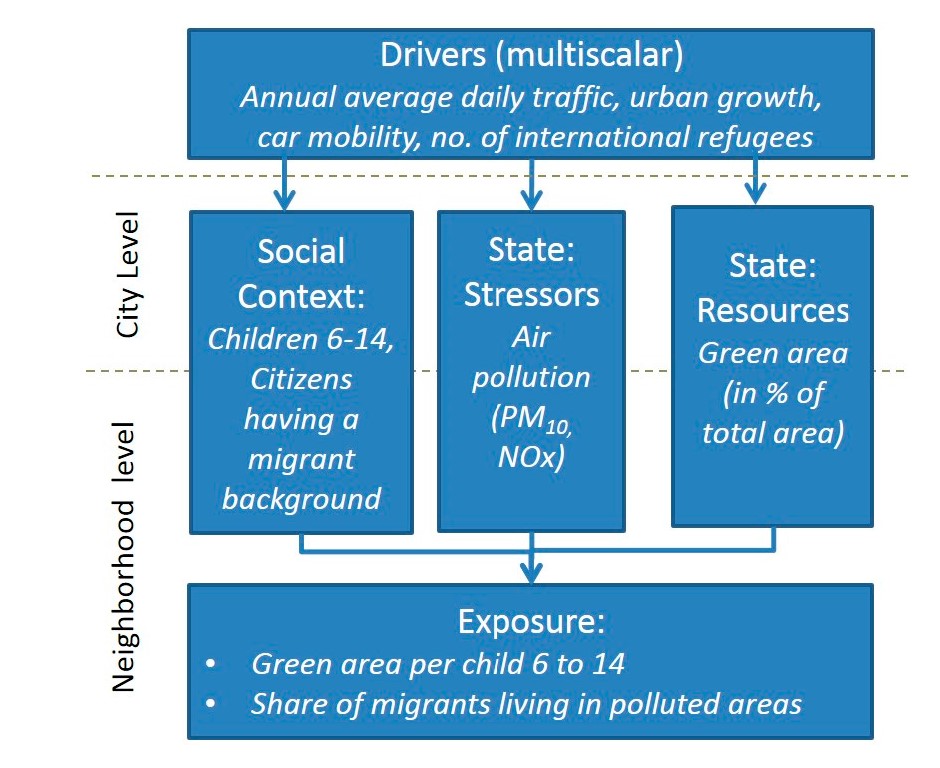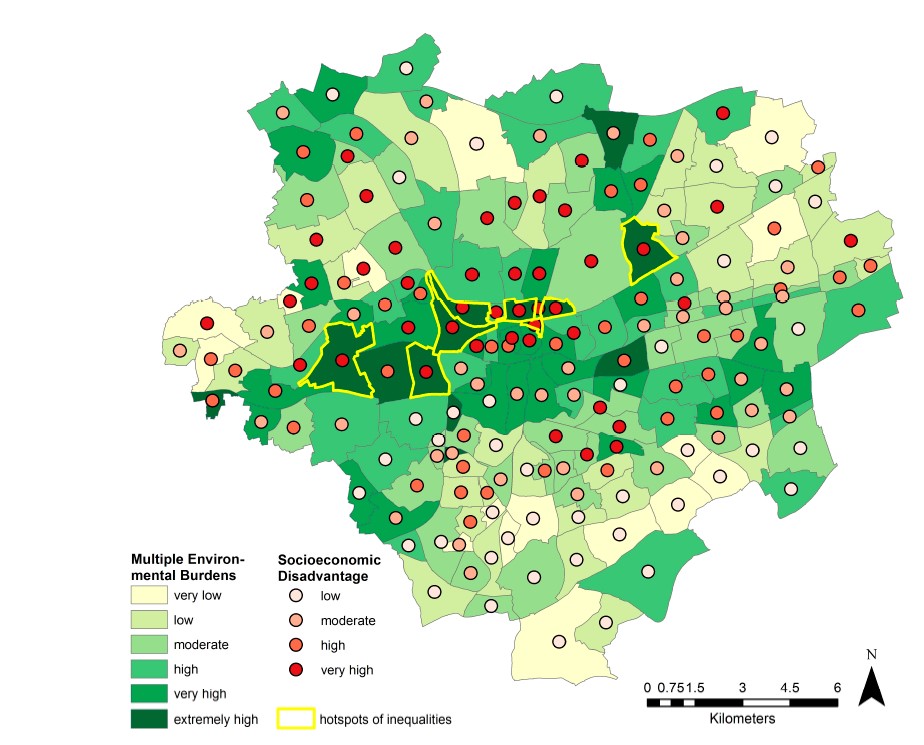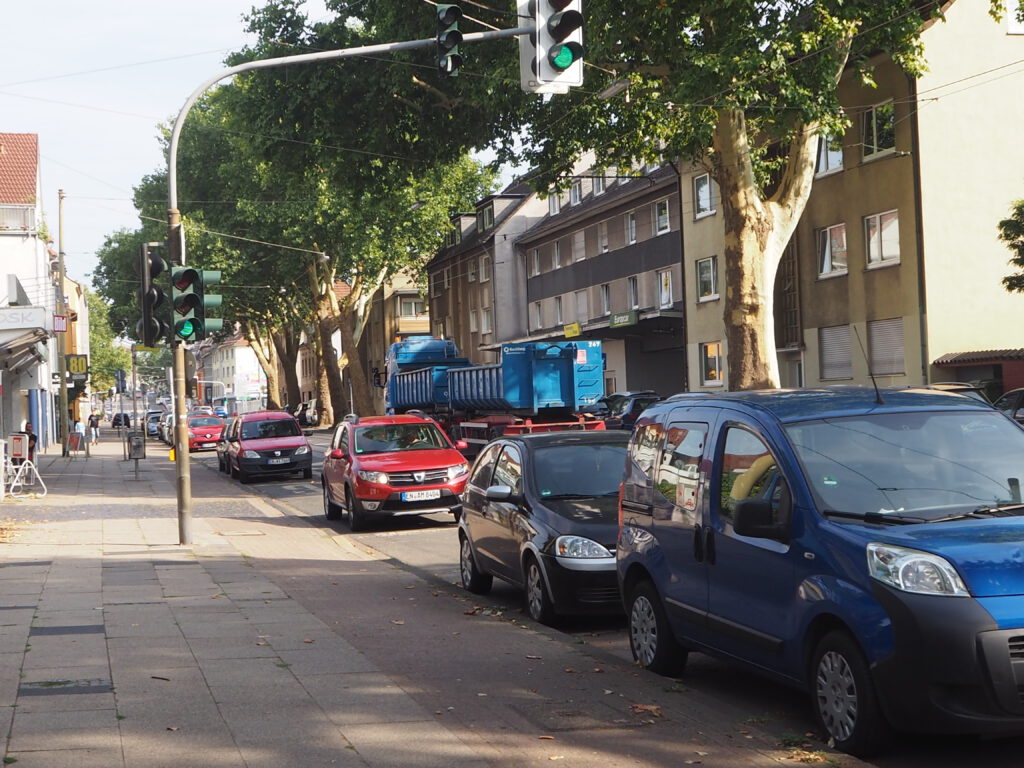Heike Köckler, Department of Community Health, Hochschule für Gesundheit, Bochum, Germany
Johannes Flacke, ITC, University of Twente, Enschede, The Netherlands
A lot is known about environmental quality in cities and its health effects: noise causes sleep problems and has effects on blood pressure, toxic air emissions may cause lung disease and walkable neighborhoods invite everyday physical activities. We find many epidemiological studies that identify environmental stressors and resources. Furthermore, some of these studies reveal social inequalities with respect to health within cities: deprived people are more often exposed to environmental burdens, have fewer resources available to cope with or to escape from these burdens – they are more vulnerable – and do in the end face more illnesses or even live shorter lives than less deprived people living in the same city (CSDH 2008).
The vision of environmental justice is to provide an alternative to this situation. Environmental justice addresses the unequal distribution of environmental resources and burdens. The distribution might be judged as being unfair because deprived people, people of a certain ethnic group, gender or age are more affected than the average population. In addition to this distributional injustice, procedural injustice is another pillar of environmental justice. Procedural justice deals with the fair treatment of all groups of society in environmental decision making and its results (Holifield et al. 2017).

Local policy-makers can act on environmental injustices and the resulting health inequalities in their decision making. Urban development – and especially urban planning – plays a crucial role in local decision making on healthy urban development (Barton & Grant 2013, Baumgart et al. 2018). As environmental justice and healthy urban development are usually wicked problems, decision making is often challenging.
As environmental justice and healthy urban development are usually wicked problems, decision making is often challenging.
A wide range of quantitative measures can help to analyse such complex systems and related problems and support decision making (CSDH 2008, Corburn and Cohen 2012, Shrestha et al. 2017).
The spatial urban health equity model (SUHEI model) was developed as a conceptual framework for indicator development to support local decision making (Flacke, Köckler 2015). It builds upon existing indicator frameworks from health and environmental science (Morris et al. 2006, Briggs 2003) and aims at (a) providing spatial representation at neighborhood level using a geographical information system (GIS), (b) representing cumulative risks, and (c) targeting interventions leading to action (Flacke, Köckler 2015, 368). Therefore the SUHEI model includes indicators that represent drivers, state and exposure of a certain system at hand. The state is divided into social context, environmental stressors and environmental resources (see Figure 1).
Looking at the model in Figure 1, one can see that the SUHEI model does not include a category for health outcome indicators. This has two reasons. First, health outcome data fulfilling requirement of availability at the neighborhood level is not easily (publically) available. Second, the number of cases representing a certain health outcome is not large enough to fulfill requirements of epidemiological research. Therefore, the SUHEI model aims at integrating indicators on the state of social and environmental factors that have been proven to lead to health effects. If a study for example proved that exposure to noise causes problems for blood pressure this does not have to be proven again for a specific city. Based on such a study we can assume that noise could be one environmental stressor indicator.
The selection of indicators should be guided by evidence from health research, data availability in the city and specific local topics. In general, different stressors, resources and indicators representing the social context could be included.

Figure 1. The SUHEI model: indicators for health promotion based on environmental justice (Flacke, Köckler 2015)
The model was applied to the city of Dortmund (Flacke et al. 2016). Figure 2 shows which indicators have been selected to apply the SUHEI model in this case study.

Figure 2. SUHEI model application to the city of Dortmund (Flacke et al. 2016)
In the data analysis we were able to show exposure to environmental burdens using specific combinations, e.g. green area per child aged 6 to 14. We also identified neighborhoods with multiple burdens and combined this information with neighborhood deprivation (see Map 1). The map builds upon a categorization of single resources and stressors. This categorization represents unequal distribution of noise, air (PM10, NOx) and green areas in Dortmund. We used quartile scores to combine different levels of stressors and resources and compare different neighborhoods. If a neighborhood has a relatively low level of stressors and a high level of resources (in the 1st quartile) it has a score of 1. If it is the other way around it has a score of 4 (4th quartile). So a neighborhood with the lowest level of relative burden has as score of 4 – four indicators in the 1st quartile – while the highest possible score is 16 – four indicators in the 4th quartile. In Map 1, a neighborhood that is characterized by relatively high levels of stressors and less resources is classified as extremely high with regard to multiple burdens. Additionally we integrated the social context, presented by dots in the map. Socio-economic disadvantage is presented by the indicator “sum of inhabitants receiving either unemployment benefits or social welfare aids”. Through combining social and environmental indicators we identified so-called hotspots: deprived, vulnerable neighborhoods exposed to multiple burdens.
Through combining social and environmental indicators we identified so-called hotspots: deprived, vulnerable neighborhoods exposed to multiple burdens.
These neighborhoods are marked with yellow borders. They are affected by distributional environmental injustice (for details on data and methods please see Flacke et al. 2016).

Map 1. Environmental justice analysis for the city of Dortmund (Flacke et al. 2016)
Decision making for a more just and healthy city can be supported by information on distributional environmental justice.
Decision making for a more just and healthy city can be supported by information on distributional environmental justice. This information can be used to prioritize actions in urban development and environmental planning. For example, noise action plans and clean air plans are mandatory instruments of environmental planning at the local level. At present these instruments consider a single environmental factor (noise or air quality) and do not take vulnerability of population into account. Information provided by the SUHEI approach offers the opportunity to take multiple burdens and social vulnerability into account. Such information gives a solid base to follow what Köckler (2014, 2017) calls the “vulnerability of population principle”. It aims at a systematic consideration of the environmental effects on vulnerable populations and furthermore of the factors that determine the vulnerability of this people. Coming back to the example of noise action planning, limited resources for a program on noise insulated windows or the implementation of speed reduction could be focused on neighborhoods which have been identified as hotspots of environmental justice.
At this moment the presented approach is a purely scientific exploration. The city of Dortmund has not yet made use of it. Our next step is to apply the SUHEI model in a real world policy environment. At present some cities have started working with the model in the context of healthy urban development, for example the health department of the city of Nuremberg, south Germany.
Finally we want to point out, that the use of data of a SUHEI model for local decision making is more precise if the level of spatial resolution is higher than in the Dortmund case study. In Germany social data is publically available on the district level only, sometimes on the level of statistical quarters. It would be more precise to apply the model at the level of blocks of houses. Such data is available to local administrations, consequently they could examine this data using the SUHEI model.
Literature
Barton, H.; Grant, M. Urban planning for healthy cities: A review of the progress of the European healthy cities programme. J. Urban Health 2013, 90, 129–141.
Baumgart, S.; Köckler, H.; Ritzinger, A.; Rüdiger, A. (Hrsg.) Planung für gesundheitsfördernde Städte. Forschungsberichte der ARL 8. Akademie für Raumforschung und Landesplanung. Hannover. 2018.
Briggs, D., Making a Difference: Indicators to Improve Children’s Environmental Health, 2003.
Corburn, J.; Cohen, A.K. Why we need urban health equity indicators: Integrating science, policy, and community. PLoS Med. 2012, 9, 1–6.
Commission on Social Determinants of Health (CSDH) Closing the Gap in a Generation: Health Equity through Action on the Social Determinants of Health—Final Report; WHO: Geneva, Switzerland, 2008.
Flacke, J.; Köckler, H. Spatial urban health equity indicators—A framework-based approach supporting spatial decision making. In Sustainable Development and Planning VII; Özçevik, Ö., Brebbia, C., ¸Sener, S., Eds.; Wit Press: Southampton, UK, 2015; pp. 365–376.
Flacke J., Schüle S., Köckler H., Bolte G. Mapping environmental inequalities relevant for health for informing urban planning interventions –a case study in the city of Dortmund, Germany; IntJEnvironResPublicHealth13, 2016,:711.https://doi.org/10.3390/ijerph13070711
Holifield, R.; Chakraborty, J.; Walker, G. The Routledge Handbook of Environmental Justice. Routledge: Oxford. 2017
Köckler, H. Environmental Justice – aspects and questions for planning procedures. In: UVPreport, 28 (3+4) 2014, 139-142.
Köckler, H. Umweltbezogene Gerechtigkeit – Anforderungen an eine zukunftsweisende Stadtplanung. Peter Lang. Frankfurt a.M.2017
Morris, G., Beck, S., Hanlon, P., Robertson, R., Getting strategic about the environment and health. Public Health; (120), pp. 889–903, 2006.
Shrestha, R; Köckler, H.; Flacke, J.; Martinez, J; van Maarseveen, M. Interactive Knowledge Co-Production and Integration for Healthy Urban Development. In: Sustainability, 9, 1945; 2017 doi:10.3390/su9111945
